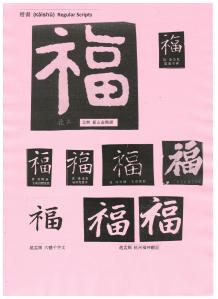春貼也稱春聯、門聯、福貼,粤語地區稱揮春。春貼是一種在新春時使用的傳統裝飾物,把賀年的吉利字詞用漂亮的書法,寫在紙上而成,一般是貼在牆、門之上。在華人社會、韓國和越南,每逢過年人們都會貼春貼,以增加節日的喜慶氣氛。其中寫成對聯的又叫春聯,不成對的春貼稱為春條。春貼亦有橫批及單字。
早在秦漢以前,中國民間過年就有懸掛桃符的習俗。以驅鬼壓邪。這種習俗持續了一千多年,到了五代,人們開始把聯語寫在桃木板上。五代後蜀主孟昶寫了中國歷史上第一則對聯:「新年納餘慶,嘉節號長春」。
宋代以後,中國民間新年懸掛春聯已經相當普遍,北宋詩人王安石詩中「千門萬戶曈曈日,總把新桃換舊符」就是當時過年盛況的真實寫照。
到了明代,人們才始用紅紙代替桃木板,出現我們今天所見的春聯。文人學士無不把作對聯視為雅事。進入清代,對聯曾鼎盛一時,出現了不少膾炙人口的名聯佳對。
Spring couplets (春聯 ) are usually seen on the sides of doors leading to people’s homes or as hanging scrolls in an interior. They used as a New Year’s decoration that expresses happy and hopeful thoughts for the coming year. They are usually written on red paper, the colour of happiness.
Originating from around 600 CE and flourishing during the last thousand year, spring couplets remain an enduring aspect of Chinese culture.

新年納餘慶 嘉節號長春 (隸書)
印章 :長春 (朱文長方印), 蕭燿漢印 (朱紋方印)
May you in the new year receive a lot of blessings
The auspicious festival is called “ever-spring”

印章 : 延年 (朱文長方印), 蕭燿漢 (白紋方印)
Forever joy throughout spring and autumn
Perpetual increments of blessing and longevity

印章 : 信望愛 (白紋長方印), 倬雲(朱紋方印)
Sharing happiness in festivals
Forever happiness in the beginning of the new year
寫在不同顏色的紙上有不同的效果。

(左: 粉紅色虎皮紙, 右: 紅色宣紙)
The Three suns initiate an era of prosperity
The Five Blessings arrive at the household
春條 :

Always happy throughout the new year
Everything fulfills expectations

Everything looks fresh and gay
May the Country prosperous and the people enjoy peace
雅俗共賞的春條 :

Congratulations and may you become wealthy
Wish you good luck when you go back to work (after the New Year Holidays)
單字春貼 :

印章 : 蕭 (朱文方印), 倬雲(白紋方印)
Happiness, blessing

Happiness, blessing

Happiness, blessing
Various styles over the years:



During 2015 Chinese New Year, Patrick’s mini-couplet was on display at the Art Gallery of NSW.

Acknowledgements:
I wish to thank Professor P. Lam for his continued guidance and support.
文字資料出自 :
Great thank you! Great to read these New Year Sayings.
LikeLike
Thank you for sharing the different types of aesthetically and pleasing Calligraphy and the history of the couplets. All the brushworks of the couplets are grandeur and excellent. It is a shame that I am not good in Chinese Calligraphy.
Joanne
LikeLike